Primary Carbine
(Requires
Course Registration Form)
This course will provide a foundation of weapon handling skills,
tactics, and combat mindset required to effectively deploy a
carbine in an armed confrontation. Shooters of every skill level
will benefit from this comprehensive carbine-fighting course.
The two days of training are fast paced and mentally challenging.
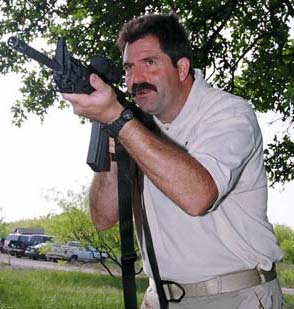
Bill Davison is one of the rare instructors
who have made a living at operational arms.
Day one will be principally conducted
in the classroom. Instruction will include comprehensive discussions
on:
- SafetyThe definition of a carbine
- Caliber and ammunition selection
- Accessorizing the weapon and shooter to properly deploy a
carbine
- The response of the mind and body to the stress of an armed
encounter
- Marksmanship fundamentals
- Combat mindset
The lecture will be followed by an extensive range session intended
to affirm correct marksmanship fundamentals and establish the
correct zero for the carbine/cartridge combination. Shooting will
range from point blank out to 200 yards.
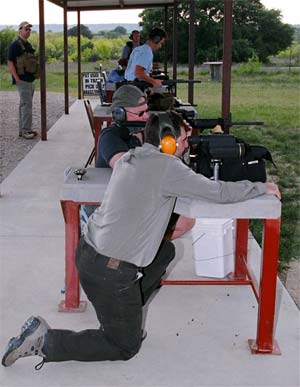
Establishing a zero and solid marksmanship
fundamentals.
Day two will include a thorough
introduction to shooting positions including how and why to assume
them, given a particular tactical situation. This will include
the introduction of time limits to develop the student’s
ability to assume a stable position and deliver effective fire
on target under pressure. Stoppage drills are a potentially life
saving skill. Murphy loves a gunfight. Stoppage drills will be
thoroughly taught and reinforced using both classroom and live
fire practice.
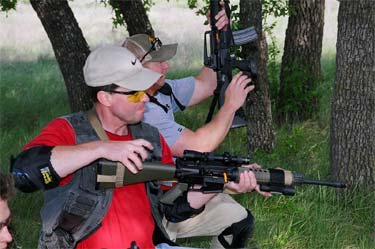
Classroom instruction on stoppage
drills using drill rounds provides the basis for developing this
life saving skill set.
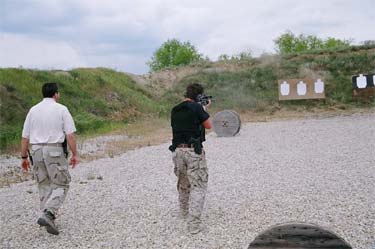
Shooting on the advance in the final
course of fire.

Shooting effectively while moving
toward the weak hand side is a vital skill.
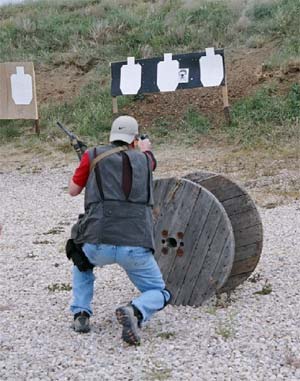
The final course of fire requires several
immediate actions drills, transition to holstered handgun.
Equipment – Carbine - New, untested, or
fresh from the gunsmith weapons are not recommend. The most prevalent
weapons in the class are AR types in 223. DPMS, Rock Rover, and
Bushmaster, to name just a few manufacturers, perform well. Vintage
military carbines, AR pattern 308s, and lever actions have been
used effectively in the course. Any serviceable rifle caliber carbine
with good quality sighting equipment is acceptable. Bring at least
6 high quality serviceable magazines. Bring a magazine pouch that
carries a minimum of four magazines on the thigh, belt, or vest.
A functional sling is required. The typical round count for this
class is between 1000 and 1500 rounds. Be certain that the ammunition
you bring for the course functions well in your weapon before getting
to the class.
Equipment – Handgun - New, untested, fresh
from the pistolsmith weapons are not recommend. Bring what you carry.
All weapon types are welcome. We believe that most students are
best served by a standard capacity (13 plus rounds) 9mm pistol.
Fine examples include the Para-Ordinance P18.9, Browning Hi-Power,
Glock models 17, 19, and 34. Loaners are available. Bring a minimum
of 4 hi-cap or 7 single stack magazines. The typical round count
for this class is between 250 and 500 rounds. Be certain that the
ammunition you bring for the course functions well in your weapon
before getting to the class. A sturdy gun belt, kydex or leather
outside the waistband holster, and a double magazine pouch are required.
The weather in north Texas can be extreme. The temperature in the
summer months can exceed 100 degrees. Dress in loose light colored
clothing and wear a wide brimmed hat. During the cooler months the
temperature can range from the low 90s to well below freezing. Be
prepared for anything. We suggest dressing in layers. We shoot rain-or-shine
so bring rain gear. Bring two pair of comfortable shoes in case
one is soaked by rain, mud, or sweat. Although this is not an athletic
event the course is physical. Kneepads and shooting gloves will
contribute to your comfort. Bring paper and pens for taking notes.
Eye and ear protection are required. Suntan lotion, Ibuprofen, band-aides,
first aide tape, and a lawn chair are a good idea.